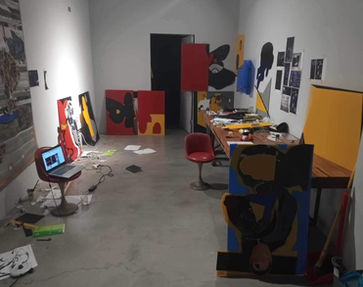
Munkhbolor Ganbold
Mongolia
Residency period
8/13/24
9/30/24
Munkhbolor Ganbold (Mongolian: Ганболдын Мөнхболор), also known as Munkkh, is a contemporary Mongolian artist who participated in the Mongolia Pavilion — Lost in Tngri at the 57th Venice Biennale in 2017.
Born in 1983 in Ulaanbaatar, Munkkh belongs to a generation of Mongolian artists shaped by the country’s turbulent transition in the 1990s. He studied at Green Horse Mongolian Contemporary Art College, the Mongolian University of Fine Arts and Culture, and later at Muthesius Fine Art College in Kiel, Germany.
After studying in Germany, Munkkh lived in Stockholm for five years, where he held solo exhibitions at Edsvik Konsthall, Sergels Torg, and Gallery Haengmattan. He returned to Ulaanbaatar in 2012, joining Blue Sun Contemporary Art Group before co-founding the Human Nature Love Freedom movement in 2013. The group presented 12 projects in public spaces and galleries until 2019.
Munkkh’s works, exhibited in Mongolia, the U.S., Italy, Korea, Taiwan, China, and Germany, incorporate found materials, often torn and repurposed. His 2017 Venice Biennale installation, Karma of Eating, explored the ecological damage caused by Mongolia’s cashmere industry.
Residency plan
Abstract patterns, symbolic figures, objects, and vibrant colors characterize most of Ganbold’s early paintings. Over time he developed complex techniques for creating large-scale collage paintings, where he used Mongolian traditional method of applique to collate torn pieces of his old works and objects and materials found on the streets. Lately he started creating two-dimensional and three-dimensional site-specific installations, juxtaposing the works with random objects and video images. Such works are usually created spontaneously in dialogue with the character of the space. Ganbold envisions the process of the exhibition can be seen as a quest for finding different solutions of working within a space, using images, objects and materials collected in Taipei, installing them with his works created in Ulaanbaatar. He also invites visitors to participate in this process throughout the exhibition period, leaving most of the elements movable, so encounters can change their positions and offer different meanings and functions through their new arrangements. Paintings, images, videos, objects, and materials, paradoxically installed at the exhibition space, will contain elements and symbols associated with different political, religious, cultural, and historical contexts. The main idea of the work is to present an ever-changing experience, where visitors may see the same objects in different arrangements, giving a sense of change and transformation. This process offers spectators possibility of playing within a space, opportunity to develop new ideas, find different connections and interpretations of various participants.
(Text: MOCA TAIPEI)









